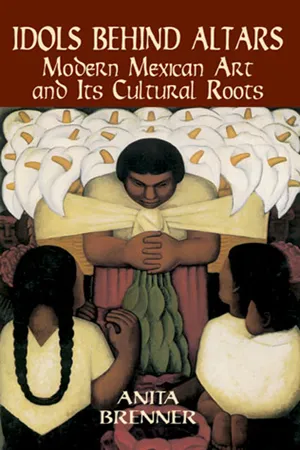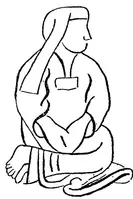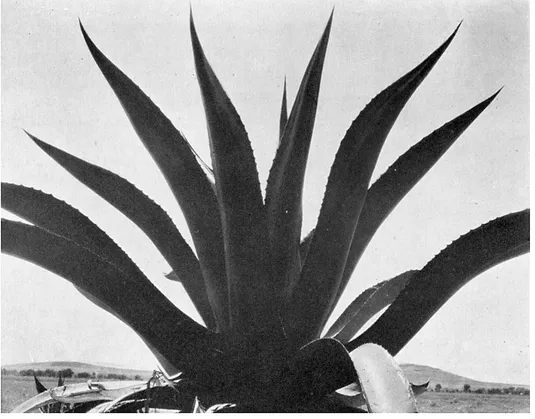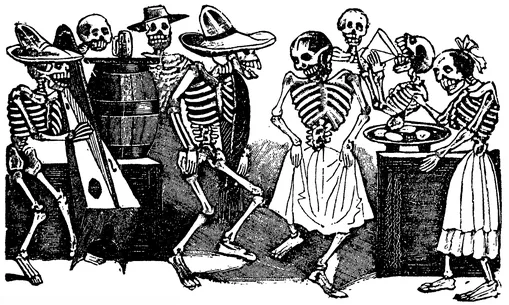![]()
PART ONE
![]()
CHAPTER ONE
MEXICAN MESSIAH
An old prophecy current in Mexico announces that “When the chief temple of the Aztecs shall appear in the principal plaza of the city of Tenochtitlan, bearing upon it the sun, then shall the ancient people possess their ancient rights.” In August, 1926, during the course of restoration and repair of the National Palace, in the main plaza of the capital, once Tenochtitlan, a monolith was brought to light. It is a model of the chief temple of the Aztecs, with a stone symbolic of the sun carved on its surface.
This is a curious piece of lore for 1926, but Mexico is a peculiar place. It is a fact that begins with the very contour of the land, torn into sudden transition, from the most luxuriant tropics to the grey, arid, rock-built heights around volcanoes. Mexico is made up of three planes: the hot lands, the cool or temperate, and the cold. They cut into and across each other so that you may stand on the top of a canyon and see snow on the mountain above you, while thousands of feet just under you, coffee and bananas grow. The dramatic and untimed juxtapositions of climates and landscapes are like the days, which everywhere go suddenly and without twilight, from white light into the night. And they are like the storms, short, powerful, saturating. Crops grow richly, disappear quickly. The land seems unfinished, and at the same time forever fixed.
Common to coast, canyon, desert and plateau, is a far horizon of purple mountain chain, inescapable as the fear that perches on the shoulder of the stranger. Most of the mountains are volcanoes, many of them are alive and occasionally stir in their sleep. Therefore they dominate in the making of that curious, insistent uncertainty that is the essence of Mexican life, bound up with the just as insistent sense of changelessness. They dominate physically. The flat-topped volcanic pyramid is repeated over and over in different scale and material. In the temples and observatories of pre-Hispanic structure; in squarish colonial missions; in village houses, thatched with palms where palms grow, and where stretches of lava girdle the fields, walled with the same sombre rock. The Indian, squatted, wrapped conically in his sarape, and his wife, swathed in her rebozo, justify by their own architecture the ancient custom of giving personal names to volcanoes.
Mountains, plants—ancient breeds, century plants, cacti, maize and calabashes—and the people, all have a tense, animal vitality. The maguey grows spikes like claws on its grey-green fibrous muscles; the maize is toothed; fruits and flesh are of the same firm blood-filled texture; and the people state facts and face them without sentimental or ethical apologia. Who stays long enough cannot escape the demands of this integrity. He may hate it, and feels impotent to scratch upon it; or he loves it with passion. He is in both cases bound to it. Women particularly find themselves tormented, and people who cannot abandon the notions brought with them from elsewhere.
With an intellectual axe to grind, this land which takes such liberties with time and space, which jazzes the social scale, which shifts into many faces, and is nevertheless a unit, becomes madness. The visitor’s mind scurries from one interpretation to another, while his being goes to pieces or evolves a new strength. He goes like the land to extremes, contracts a permanent faith like the Indian’s, or a permanent doubt like the mestizo’s; drinks himself to disease like most foreigners, or writes poetry, sings, paints pictures, like most natives. For the dust of Mexico on a human heart corrodes, precipitates. But with the dust of Mexico upon it, that heart can find no rest in any other land.
Without the need for translation or a story sequence, Mexico resolves itself harmoniously and powerfully as a great symphony or a great mural painting, consistent with itself, not as a nation in progress, but as a picture, with certain dominant themes, certain endlessly repeated forms and values in constantly different relationships, and always in the present, like the Aztec history-scrolls that were also calendars and books of creed.
II.
“Look around,” says an ancient Mexican poet, “and wonder at this scene of many-colored houses . . . created and endowed with life. They make us who are miserable to see the light among the flowers and songs of the fertile fields, they cause us to see those things . . . created and endowed with life. They dwell in the place of spring, here within the broad fields, and only for our sakes does the turquoise water fall in broken drops on the surface of the lake. Where it gleams forth in fourfold rays, where the fragrant yellow flowers bud, there live the Mexicans, the youths.”
Ever recurrent in Mexican thought, is this concern with the sheer fact of life. Life shifting from one form to another, and all still the same; movement defined by stops; light endlessly becoming darkness, plants and people of necessity dying, at a definite fixed point, to be reborn. Hence the constant considering of death, and hence the Mexican messiah.
The Mexican messiah began with the first sun and life-giver, in legend a most miserable and leprous brother of a family of gods, who was transformed in fire and thereafter climbed into the sky. The sun, the mountains, the gods, the heroes (of necessity martyrs), healers and rebels—this is the stuff of which the messiah is made. His form is multiple. There may be many of him at once. Always he is the same messiah, projection of divinity. Always he must die, always return. He is fundamentally an abstract principle, the function of which is to kindle, maintain, justify, embody and give life.
Texcatlipoca the perennially youthful Smoking Mirror, or Fiery Rock, was a mountain, the night wind, a jaguar, and was present, although essentially invisible, in the forms of priests and of people bearing his name or wearing garments like his. He was dramatically synthesized yearly in the living body of the most beautiful male captive, who was honored for the seasons’ cycle and worshipped as the god. At the end of the year he died, to nourish the sun, which could thereby live and make the next year’s crops spring up again. Quetzalcoatl the Plumed Serpent, was water, the south wind, reptile, bird, plants, doctor, teacher, astronomer, priest, king, and ordinary wise person. As king he taught the people agriculture and how to measure time and the stars. Then he sailed away in a white-winged boat, promising to return. As wind and serpent, priest and ordinary wise person, he was considered to be still present.
The Tepozton of Tepoztlan, a mountain village near the capital, is, as his name signifies, lord of the mountain on which his temple stands. He is also the ancient Ometochtli who helped to discover the fertile maguey with its bowl of intoxicant milk. He is each of the kings who ruled the village. He is the boy who today takes care of his ruined house. And he is the man who yearly dresses in red and green and sings a triumphant defiant Aztec chant in the churchward of Our Lady of Natividad. Catholic patroness of the pueblo and dweller at the foot of the Tepozton’s mountain. He is the favorite son of this Lady, though when she first arrived he angrily blasted the crops as the wind, and as a deadly white worm at the roots of the maize. He appeared on the shoulder of his mountain as a great serpent and as lightning, as a jaguar with tremendous jaws and a horrible roar, as a radiant being with waving head-dress, riding the storm. The Tepozton “usually walks about the fields and attends to the crops and other matters of the people’s welfare.” He is then dressed as a peasant with a straw sombrero on his head. “Thus it is known that he is poor and one of us.” When the rain is late he appears in dreams or out of them, clothed magnificently in red and green ribands and plumes, “and thus it is known that he is a god.” He makes his wishes known. They are fulfilled, and it rains. During the revolution he helped the peasant rebels against the Federal soldiers. The Tepozton, like the Teutli of Milpa Alta, like the Lord of Chalma, like the long-haired mourning Malintzin, “is a powerful person; but what he has of bad he has of good, too.” He, and all the deities, it is frequently asserted, “Sleep in the mountains. They sometimes stir. But some day they will awake, and shake, and pour forth lava and boiling water, a great and barbarous breath. Then the people will no longer carry burdens on their backs.”
4. LEAD SOLDIERS FROM GUADALAJARA
In Mexican mood the messiah is always accompanied by disaster: an earthquake, a conquest, a revolution, the sacrifice of a ruler; death and pain. Therefore all the prophecies which promise restoration are complemented by announcements of catastrophe. New life, the fires rekindled by the ancient Mexicans at the end of each fifty-two-year cycle, was made after the darkening of these fires, destruction of possessions, with the sense of impending obliteration. The cycles were not arranged in sequence. Each was a completely new beginning, repeating the days and events of the past, with the same names and the same coincident events. Thus the prophecies were as calendrical as the seasons. The martyr-messiah was dated.
The return of Quetzalcoatl was set for the end of a cycle that proved to be the last of the Aztec Empire. He was heralded by comets, earthquakes, sinister messengers. Moctezuma was warned that the end of his reign was near, and with it his own death. Then Cortez materialized the white and bearded—maize-like but un-Aztec—human form of the radiant Serpent. In the eighteenth century just before the War of Independence, two cultured Spanish gentlemen entered unannounced the hut of an Indian in a garden suburb of Mexico City, and surprised “a very old man squatting on his mat, with a pair of spectacles on his nose, studying a hieroglyph chart or picture-map.” He quickly flicked it out of sight, but, urged and questioned, he explained that “he had been figuring out the time set for the end of the Spanish reign.”
Netzahualcoyotl the Aztec poet king sang the two facets of the ever-continuous Mexican persuasion of which the messiah is the symbol.
“I foresaw, being a Mexican, that our rule began to be destroyed.
“I went forth weeping that it was to bow down and be destroyed.
“Let me not be angry that the grandeur of Mexico is about to be destroyed.
“The smoking stars gather together against it; the one who cares for flowers is about to be destroyed.
“He who cared for books wept, he wept for the beginning of the destruction.”
Then in another poem he chants, “The darkness of the sepulchre is but a strengthening couch for the glorious sun, and the obscurity of the night but serves to reveal the brilliance of the stars. . .”
While on a different plane, another chanter echoes him: “The disdained and the slaves shall go forth with song; but in a little while their oppressors shall be seen in the fire, amid the howling of wolves.”
It is the same persuasion still. There is a good deal of faith in these prophecies. Many of them come true, and in schedule. They circulate among the otherwise inarticulate, by word of mouth, in ballads, hymns, penny broadsides, by gesture almost. One hardly knows how, but the feeling is there. Sooner or later the mountains and the men produce corroboration. In the years when the revolution of 1910 was brewing, and just before the pot boiled over, although the dictator did not know it, the people spoke among themselves of what was soon to come. I remember being held up above a mob to watch the great glare of a comet in the sky, and the old woman who held me said: “It means war, death, misery, hunger and disease.” Soon after that it rained ashes for a night and a day from a distant erupting volcano. The people said: “After this it will rain blood.”
When Madero, political head of the turmoil that followed, rode triumphant into the capital, he was greeted by a wildly enthusiastic mass, black on the roofs and jammed in the windows. But that same day an earthquake in the city split a big building in half. It was said, and Madero knew it, that he was soon to die. Out in the mountains of Morelos, Zapata, with his brutal, passionate peasant troop, was clamoring for the ancient lands. In Yucatan Felipe Carrillo Puerto was teaching the Maya peons their constitutional rights. They died for it, as they both knew they would.
Then afterwards there arose in the mountains of the north a nameless Indian boy who was called the Miraculous Child Fidencio. The Miraculous Fidencio, insists a penny pamphlet as anonymous as a ballad, “Is not like the numberless witchdoctors, bone-setters, hypnotists and other such individuals who now and again rise up in Mexico, particularly in the fields. . . The chronicles of the eighteenth century speak of Tzantzen, a mountain Indian from Zacatecas, extraordinarily learned in the curative powers of herbs and plants. Towards the end of the War of Independence there arose the somewhat unreal figure of Sor Encarnación, a nun escaped from one of the convents to become the aid and comfort of the Mexican guerrilla men. It was said that he who drank of the fountain which had sprung miraculously from her touch was cured of all his ills, and his wounds turned to scars . . . In these last few years countless cure-people have arisen. Rutila, the little old woman of the Blue Water, in Guadalajara, who offered to resuscitate the governor. . . Maria Auxiliadora (Mary the Helper) a peasant woman of San Luis Potosí . . . Don Erasmo Mata, that facetious Don Erasmo who with equal affability foretold the end of the world and cured the sick by means of the magic feathers of his prophet game-cock. But Fidencio stands apart, a pure, serene, and humble figure, a generous Child who makes paralytics walk while he sings to them naive ballads and chants, and gives out among the poor the gold and gifts of those in power.”
Shortly after his appearance in 1928, Fidencio announced that he had not long to live. The nation must hasten to him to be healed, for he could give it only two years. A city sprang up in the desert around him, permanently inhabited by changing hundreds of beggars for sight, for speech, for movement, for life. It was called the Place of Pain. Many of the healed declared that the power of Fidencio rested in the brew he made by throwing into a great vat of running water, the gifts of flowers and fruit that came to him. Others said that this power came from the songs he sang. His favorite was a lyric about and to a Blue Lily of the Mountain. It is a song of love and can, one hears, make death easier, and quiet any pain. Most often it was said that Fidencio’s power came from the Place of Pain itself. The tree under which he wept and prayed to be given the boon of healing became a shrine and an altar. Candles burned around it and supplicants knelt on its roots. But Fidencio would not have these explanations. He said: “Those who suffer have the Grace of God. By suffering, health is reached, and it is necessary that this should be so, because those who desire to be well, should be strengthened by sorrows and pain.”
III.
The ancient Mexican concern with death which created the messiah, remains like the messiah an organic part of Mexican thought. As a motif in art it springs from before the Conquest, cuts through the colonial period and appears over and over today. There are skulls in monolith of lava, miniature of gold and crystal, mask of obsidian and jade; skulls carved on walls, moulded upon pots, traced on scrolls, woven into garments; formalized into hieroglyphs, given a skeleton and an occupation in figurines; filled out around whistles, savingsbanks, rattles, bells, holiday masks and jewels; woodcut and etched on ballads; strung into drinking-shop decorations; made into candles and toys. The skull has many meanings in Mexican argot. It trails gods, clowns, devils and subsidiary bogies in Mexican lore. There is a national holiday for it.
The Day of the Dead was fixed by the missionary friars according to the Christian calendar, but it was a habit long before. This holiday comes on the first and second of November. All Saints’ Day is all adult ghosts’ day, and All Souls’ day belongs to the children. The spirits return according to their ages, on the first and second eve, to dine with their living relatives. The table is set on an altar. There are beans, chili, tortillas, rice, fruit, other daily dishes, and the specialties of the season: pumpkins baked with sugar-cane, pulque or a bluish maize-brew with a delicate sugar film, and Dead Mens’ Bread. For the children, candy skulls, pastry coffins, ribs and thigh-bones made of chocolate and frosted sugar, tombstones, wreaths, and pretentious funerals.
5. RETURN OF THE DEAD
Illustration for popular ballad, by Guadalupe Posada
The living do not eat of the feast until the dead have left. They sit up all night “with the little dead ones” (affectionate term for invisible human beings) as if at a wake—a Mexican wake; singing, praying, drinking, making a little love. And it is a wake, except that the prayers are said not for the dead, but to them. Everybody “weeps the bone” picnicking in the graveyards. The tombs are turned into banquet tables similar to those at home. The food is put upon them, on banks of flowers, heavy purple wild blossoms and the yellow pungent cempoalxochitl, ancient and sacred bloom. Little flags fly from the mounds; sometimes arcades and booths are raised over them, as upon holiday canoes. The recently bereaved or the especially punctilious really may shed a few tears for the honoured “bone.” But somehow these tears are like the flowers and the skulls, simply part of the gesture. One’s respected relatives, who ...




